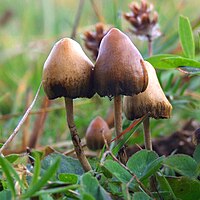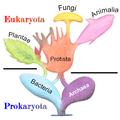The Fungi Portal
A fungus is any member of a large group of eukaryotic organisms that includes microorganisms such as yeasts and molds, as well as the more familiar mushrooms. The Fungi are classified as a kingdom that is separate from plants and animals. The discipline of biology devoted to the study of fungi is known as mycology or fungal biology, which is historically regarded as a branch of botany, even though genetic studies have shown that fungi are more closely related to animals than to plants. Fungi reproduce via spores and grow as hyphae, mycelia, and further specialized structures. Fungal spores are often produced on specialized structures or in fruiting bodies, such as the head of a mushroom. Abundant worldwide, most fungi are mostly invisible to the naked eye because of the small size of their structures, and their cryptic lifestyles in soil, on dead matter, and as symbionts of plants, animals, or other fungi. Fungi perform an essential role in the decomposition of organic matter and have fundamental roles in nutrient cycling and exchange. They have long been used as a direct source of food, such as mushrooms and truffles, as a leavening agent for bread, and in fermentation of various food products, such as wine, beer, and soy sauce.
Since the 1940s, fungi have been used for the production of antibiotics, and, more recently, various enzymes produced by fungi are used industrially and in detergents. Fungi are also used as biological agents to control weeds and pests. Many species produce bioactive compounds called mycotoxins, such as alkaloids and polyketides, that are toxic to animals including humans. The fruiting structures of a few species are consumed recreationally or in traditional ceremonies as a source of psychotropic compounds. Fungi can break down manufactured materials and buildings, and become significant pathogens of humans and other animals. Losses of crops due to fungal diseases or food spoilage can have a large impact on human food supplies and local economies. Despite their importance on human affairs, little is known of the true biodiversity of Kingdom Fungi, which has been estimated at around 1.5 million species, with about 5% of these having been formally classified.
| More about fungi... |
Selected article
Dendrocollybia racemosa fruit bodies have small pale grayish-white or grayish-brown caps up to 1 cm (0.4 in) wide, and thin stems up to 6 cm (2.4 in) long. The species is characterized by its unusual stem, which is covered with short lateral branches. The branches often produce spherical slimeheads of translucent conidiophores on their swollen tips. The conidiophores produce conidia (asexual spores) by mitosis. Because the fungus can rely on either sexual or asexual modes of reproduction, fruit bodies sometimes have reduced or even missing caps. The unusual stems originate from black pea-sized structures called sclerotia. The anamorphic form of the fungus, known as Tilachlidiopsis racemosa, is missing the sexual stage of its life cycle. It is able to reproduce at relatively low temperatures, an adaptation believed to improve its ability to grow quickly and fruit on decomposing mushrooms.
Selected species
The mushroom grows on grassy meadows and similar habitats, particularly in wet, north-facing fields and other habitats well-fertilized by sheep and cattle feces. But unlike P. cubensis and P. coprophila, it does not grow directly on the dung. The species is found in fields where animals graze throughout the cool temperate and subarctic regions of the Northern Hemisphere, but it is known primarily from continental Europe, the UK and Ireland. However, it has also been reported occasionally from India, South America, and Australasia. It is the world's most common psychoactive mushroom, and one of the most potent. The mushroom has also been shown to inhibit an antibiotic-resistant form of the human pathogen Staphylococcus aureus, and it may suppress growth of the plant pathogen Phytophthora cinnamomi.
Things to do
If you want to help Wikipedia to improve its coverage of fungi, here are some things you can do...
- Assess some fungi articles.
- Join Wikipedia:WikiProject Fungi or ask on the talk page.
- Join the lichen task force.
- Review, improve, expand or clean some of the newly created fungi-related articles.
- Expand some high priority fungus stubs.
- Expand or sort other fungi-related stubs.
- Add images to articles in the list of unillustrated fungi articles, or add more articles to the list.
- Write fungi-related articles from scratch. For ideas of needed articles, see the redlinks on-
- Review the fungi articles flagged as needing attention.
WikiProjects
WikiProjects related to fungi:
Selected picture
Did you know?
- ... that in Mexico, the mushroom Boletus frostii is commonly known as panzia agria, which translates to "sour belly"?
- ... that the yellow wart is often confused with the fly agaric?
- ... that the largest specimens of the sandy stiltball fungus have been found growing in floodplains with halophilic vegetation?
- ... that Geastrum triplex is considered the largest of the earthstar fungi?
- ... that the puffball mushroom Calvatia sculpta has been described as "a cross between a geodesic dome and a giant glob of meringue"?
General images -
Related portals
Topics
- Main topics lists: Outline of fungi and Outline of lichens
- Fungi: Bracket fungus, carnivorous fungus, coprophilous fungi, entomopathogenic fungus, evolution of fungi, lichen, mushroom, mycology (lichenology, mycotoxicology, paleomycology), mycorrhiza, pathogenic fungi, puffball, wood-decay fungus
- Fungal orders: Chytridiomycota, Blastocladiomycota, Neocallimastigomycota, Zygomycota, Glomeromycota. Dikarya: Ascomycota, Basidiomycota
- Fungi lists: Species: Agaricus species, Amanita species, Boletus species, Cortinarius species, Cyathus species, Hygrocybe species, Hygrophorus species, Inocybe species, Lactarius species, Mycosphaerella species, Panaeolus species, Psilocybe species, Russula species, Scleroderma species Other lists: Mycology journals, psilocybin mushrooms
- Uses: Edible mushroom, mushroom poisoning, psilocybin mushrooms, mushroom hunting, fungiculture, fermentation, baker's yeast, mycoremediation, lichenometry, mushroom dye







![Image 3Pennate diatom from an Arctic meltpond, infected with two chytrid-like [zoo-]sporangium fungal pathogens (in false-colour red). Scale bar = 10 μm. (from Marine fungi)](http://upload.wikimedia.org/wikipedia/commons/thumb/b/b5/Pennate_diatom_infected_with_two_chytrid-like_fungal_pathogens.png/120px-Pennate_diatom_infected_with_two_chytrid-like_fungal_pathogens.png)

























































